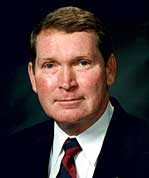John Fogg | |
|---|---|
 Fogg in 2022 | |
| 60th Mayor of Pensacola | |
| In office 1994–2009 | |
| Preceded by | Jerry L. Maygarden |
| Succeeded by | Mike Wiggins |
| Personal details | |
| Born | December 30,1944 Greensburg,Indiana |
| Spouse | Patrica Fogg |
| Residence | Pensacola,Florida |
| Alma mater | Butler University (BA) Troy State University (MPA) |
| Profession | Mayor of Pensacola,Marine |
John Fogg (born December 30,1944) is an American politician who served as the mayor of Pensacola,Florida,from 1994 to 2009. Fogg was appointed to the post by the Pensacola City Council in 1994,and reappointed in 1995,1997,and 1999. In 2001,he became the first elected mayor since 1913.
